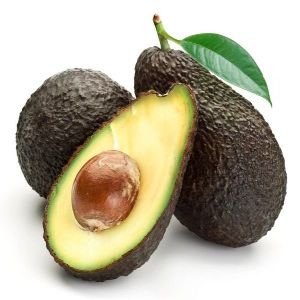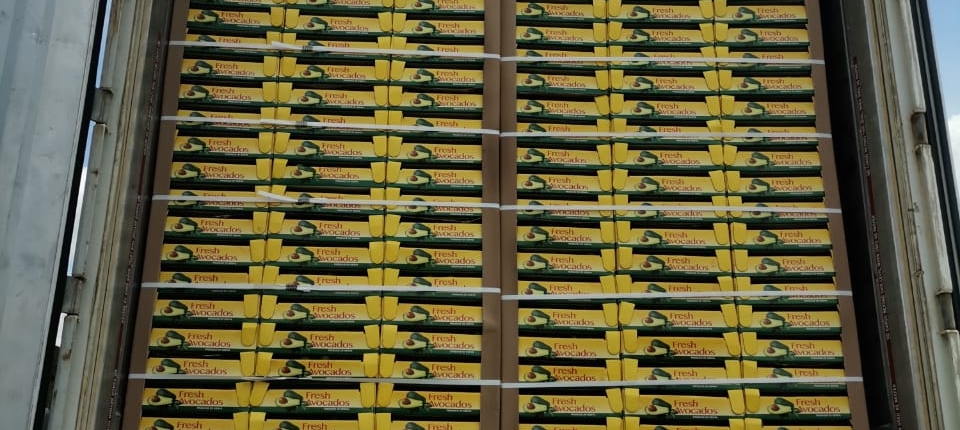Fruits
- Avocado
- Hass
Hass avocados have a pebbly thick skin that ripens from green to deep purple or nearly black. The flesh closest to the skin is pale green, and as it nears the medium-sized central stone (seed) it develops a yellow undertone. The flesh is soft, creamy, and barely fibrous, with good oil content. The flavor is rich and nutty with a slightly sweet finish. It is a high growing yield and, in some areas, year-round harvesting. The Hass cultivar is the most commercially popular avocado worldwide.
Details
Weight: per pease –200-300 grams
Packaging: cartons of 4 kg net
Recommended storage & transport temperature: 5 °C
Nutritional Value: Rich in vitamin C, vitamin E, potassium, folic acid, dietary fiber, and a good source of monounsaturated fat.
AVAILABILITY: MARCH – OCTOBER
- Fuerte
The Fuerte avocado is often recognized as the archetypal avocado, green in color, pear-like in shape. It is marginally oily with a rich, and creamy flavor. Their skin remains green, and the fruit will yield to gentle pressure when ripe. Unlike most fruits, the avocado does not ripen on the tree and instead begins to ripen once harvested, and their sugar level actually decreases as they mature.
Details
Weight: per pease –170-340 grams
Packaging: cartons of 4 kg net
Recommended storage & transport temperature: 5 °C
Nutritional Value: Contains protein, potassium, magnesium, folic acid, thiamin, riboflavin, niacin, biotin, pantothenic acid, vitamin E, vitamin K monounsaturated fat, such as oleic acid, which is thought to prevent breast cancer and prostate cancer.
AVAILABILITY: MID JANUARY – AUGUST
- Mango
Apple Mangoes
This variety originated from the Kenya coastline, most probably around the Malindi area. It is a chance seedling and its parentage is unknown. The fruits are medium to large, nearly round in shape and have a rich yellow/orange to red colour when ripe.
Average length measures 9.7 cm by 11 cm in width, and the weight is 280-580 g (mean: 397 g). Normally, if not diseased, the skin is smooth and thin, and the juicy yellow flesh is of excellent flavour and of melting texture virtually free from fibre. This is not a polyembryonic cultivar and trees propagated by seed are very heterogeneous in fruit shape, colour and quality. The trees are large/vigorous and of pyriform growth habit. Depending on location, harvesting seasons are from December to the beginning of March; the yields are medium
Ngowe Mango
The original Ngowe tree (so it is believed) was brought from Zanzibar and planted in Lamu approximately 1897. This typical coastal cultivar, also known as Lamu mango, can now be found all along the coastline and has also adapted well to medium altitude locations. Ngowe is the most easily recognized of the local mango fruits. It is large, oblong and slender with a very prominent hook-like beak at the apex. From pale green, the fruit develops to a most attractive yellow to orange color when ripe. The deep yellow flesh is of excellent quality, virtually free from fibre, melting, and carries no turpentine taste. The average fruit length measures 14 cm with a width of 9.5 cm, and a weight range of 425—600 g (mean: 523 g). The seeds are polyembryonic which means progeny develops more or less true-to-type. The trees are comparatively small and round in shape. Depending on location, harvesting may start in November and continue until March. Yields are medium and alternate bearing may occur.
Kent Mango
This open pollinated seedling of the cultivar Brooks originated in Miami, Florida, and was released in 1944. Kent is often mistaken for the quite similar looking cultivar Keitt but (just one difference) Kent matures earlier (March).The large fruit is greenish-yellow with a red or crimson blush on the shoulder. The average length measures 12.4 cm with a width of 9.7 cm and an average weight of 545 g. The fruit-shape is regular ovate with a rounded base and often with two slight beaks.The skin is thick and tough and small yellow lenticels are numerous; the flesh is juicy, melting, deep yellow, fibreless and of a rich flavor. The seed, embedded in a thick, woody stone (8.5% of fruit weight) is mono-embryonic. The tree is large and vigorous, with a dense upright canopy, and it produces good yields in the late mid-season.















